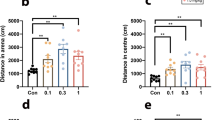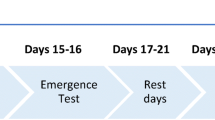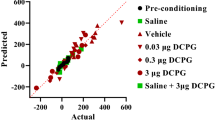Abstract
Rationale
Group I metabotropic glutamate receptor antagonists, which block both the mGlu1 and mGlu5 receptors, have been shown to have anxiolytic effects in the lick suppression test in rats.
Objective
The anxiolytic potential of the selective mGlu1 antagonist 3,4-dihydro-2H-pyrano[2,3]β-quinolin-7-yl)(cis-4-methoxycyclohexyl)methanone (JNJ16259685) was investigated and compared with the mGlu5 antagonist MPEP.
Methods
Anxiety-related behaviour was assessed in lick suppression and in the elevated zero maze in rats. Non-specific effects on pain threshold, water intake and locomotor activity were also measured.
Results
Acute administration of JNJ16259685 or MPEP increased the number of licks (lowest active dose 2.5 mg/kg IP for each compound). JNJ16259685 did not increase water intake or reduce acute pain threshold, suggesting that the anxiolytic-like properties are specific. However, acute administration decreased locomotor activity. The effects of chronic administration of JNJ16259685 over 14 days (5 mg/kg bid) on lick suppression were comparable to those seen after acute administration, arguing against development of behavioural tolerance or sensitisation. Yet, there was a tendency for an increase in locomotor activity after cessation of chronic treatment. Acute co-administration of both JNJ16259685 and MPEP had additive effects on the number of licks. No anxiolytic-like properties of JNJ16259685 were observed in the elevated zero maze.
Conclusion
Our data suggest that the anxiolytic-like effects induced by group I metabotropic glutamate receptor antagonists are mediated through both mGlu1 and mGlu5 receptors. Rather than producing a general anxiolytic-like effect, the effects seen following mGlu1 antagonism seem task-dependent, as prominent effects were seen in a conflict procedure, but not in a task based on spontaneous exploration.







Similar content being viewed by others
References
Baude A, Nusser Z, Roberts JD, Mulvihill E, McIlhinney RA, Somogyi P (1993) The metabotropic glutamate receptor (mGluR1 alpha) is concentrated at perisynaptic membrane of neuronal subpopulations as detected by immunogold reaction. Neuron 11:771–787
Bordi F, Ugolini A (1999) Group I metabotropic glutamate receptors: implications for brain diseases. Prog Neurobiol 59:55–79
Brodkin J, Busse C, Sukoff SJ, Varney MA (2002) Anxiolytic-like activity of the mGluR5 antagonist MPEP. A comparison with diazepam and buspirone. Pharmacol Biochem Behav 73:359–366
Chojnacka-Wojcik E, Tatarczynska E, Pilc A (1997) The anxiolytic-like effect of metabotropic glutamate receptor antagonists after intrahippocampal injection in rats. Eur J Pharmacol 319:153–156
Conn PJ, Pin JP (1997) Pharmacology and functions of metabotropic glutamate receptors. Annu Rev Pharmacol Toxicol 37:205–237
Corbett R, Dunn RW (1991) Effects of HA 966 on conflict, social interactions and plus maze behaviors. Drug Dev Res 24:201–205
Corbett R, Dunn RW (1993) Effects of 5,7-dichlorokynurenic acid on conflict, social interaction and plus maze behaviors. Neuropharmacology 32:461–466
Cozzi A, Meli E, Carla V, Pellicciari R, Moroni F, Pellegrini-Giampietro DE (2002) Metabotropic glutamate 1 (mGlu1) receptor antagonists enhance GABAergic neurotransmission: a mechanism for the attenuation of post-ischemic injury and epileptiform activity? Neuropharmacology 43:119–130
Fundytus ME, Fisher K, Dry A, Henry JL, Coderre TJ (1998) In vivo antinociceptive activity of anti-rat mGluR1 and mGluR5 antibodies in rats. Neuroreport 9:731–735
Fundytus ME, Yashpal K, Chabot JG, Osborne MG, Lefebre CD, Dray A, Henry JL, Coderre TJ (2001) Knockdown of spinal metabotropic glutamate receptor 1 (mGlu1) alleviates pain and restores opioid efficacy after nerve injury in rats. Br J Pharmacol 132:354–367
Gasparini F, Lingenhohl K, Stoehr N, Flor PJ, Heinrich M, Vranesic I, Biollaz M, Allgeier H, Heckendorn R, Urwyler S, Verney MA, Johnson EC, Hess SD, Rao SP, Sacaan AI, Santori EM, Velicelebi G, Kuhn R (1999) 2-methyl-6-(phenylethynyl)-pyridine (MPEP), a potent, selective and systemically active mGlu5 receptor antagonist. Neuropharmacology 38:1493–1503
Klodzinska A, Tatarczynska E, Chojnacka-Wojcik E, Pilc A (2000) Anxiolytic-like effects of group I metabotropic glutamate antagonist 2-methyl-6-(phenylethynyl)-pyridine (MPEP) in rats. Pol J Pharmacol 52:463–466
Klodzinska A, Tatarczynska E, Stachowicz K, Chojnacka-Wojcik E (2004) The anxiolytic-like activity of AIDA (1-aminoindan-1,5-dicarboxylic acid), an mGlu 1 receptor antagonist. J Physiol Pharmacol 55:113–126
Lavreysen H, Le Poul E, Van Gompel P, Dillen L, Leysen JE, Lesage AS (2002) Supersensitivity of human metabotropic glutamate 1a receptor signaling in L929sA cells. Mol Pharmacol 61:1244–1254
Lavreysen H, Nobrega S, Leysen JE, Langlois X, Lesage ASJ (2004a) Metabotropic glutamate 1 receptor distribution and occupancy in the rat brain: a quantitative autoradiographic study using [3H]R214127. Neuropharmacology 46:609–619
Lavreysen H, Wouters R, Pereira SN, Langlois X, Lesage ASJ (2004b) JNJ16259685, a highly potent, selective and systemically active mGlu1 receptor antagonist. Neuropharmacology (in press)
Monaghan DT, Bridges RJ, Cotman CW (1989) The excitatory amino acid receptors: their classes, pharmacology, and distinct properties in the function of the central nervous system. Ann Rev Pharmacol Toxicol 29:365–402
Moroni F, Lombardi G, Thomsen C, Leonardi P, Attucci S, Peruginelli F, Torregrossa SA, Pellegrini-Giampietro DE, Luneia R, Pellicciari R (1997) Pharmacological characterization of 1-aminoindan-1,5-dicarboxylic acid, a potent mGluR1 antagonist. J Pharmacol Exp Ther 281:721–729
Neugebauer V, Chen PS, Willis WD (1999) Role of metabotropic glutamate receptor subtype mGluR1 in brief nociception and central sensitization of primate STT cells. J Neurophysiol 82:272–282
Pin JP, Duvoisin R (1995) The metabotropic glutamate receptors: structure and functions. Neuropharmacology 34:1–26
Roche KW, Tingley WG, Huganir RL (1994) Glutamate receptor phosphorylation and synaptic plasticity. Curr Opin Neurobiol 4:383–388
Rodriquez SM, Bauer EP, Farb CR, Schafe GE, LeDoux JE (2002) The group I metabotropic glutamate receptor mGluR5 is required for fear memory formation and long-term potentiation in the lateral amygdala. J Neurosci 22:5219–5229
Salt TE, Turner JP (1998) Reduction of sensory and metabotropic glutamate receptor responses in the thalamus by the novel metabotropic glutamate receptor-1-selective antagonist S-2-methyl-4-carboxy-phenylglycine. Neuroscience 85:655–658
Salt TE, Turner JP (2001) Group I metabotropic glutamate receptors and sensory transmission through the thalamus: an overview. In: Turski L, Schoepp DD, Cavalheiro EA (eds). Excitatory amino acids: ten years later, pp 129–137
Schulz B, Fendt M, Gasparini F, Lingenhohl K, Kuhn R, Koch M (2001) The metabotropic glutamate receptor antagonist 2-methyl-6-(phenylethynyl)-pyridine (MPEP) blocks fear conditioning in rats. Neuropharmacology 41:1–7
Shepherd JK, Grewal SS, Fletcher A, Bill DJ, Dourish CT (1994) Behavioural and pharmacological characterisation of the elevated “zero-maze” as an animal model of anxiety. Psychopharmacology 116:56–64
Shigemoto R, Nakanishi S, Mizuno N (1992) Distribution of the mRNA for a metabotropic glutamate receptor (mGluR1) in the central nervous system: an in situ hybridization study in adult and developing rat. J Comp Neurol 322:121–135
Spooren W, Vassout A, Neijt H, Kuhn R, Gasparini F, Roux S, Porsolt R, Gentsch C (2000) Anxiolytic-like effects of the prototypical metabotropic glutamate receptor 5 antagonist 2-methyl-6-(phenylethynyl)pyridine in rodents. J Pharmacol Exp Ther 295:1267–1275
Spooren WPJM, Gasparini F, Salt TE, Kuhn R (2001) Novel allosteric antagonist shed light on mGlu5 receptors and CNS disorders. Trends Pharmacol Sci 22:331–337
Spooren W, Ballard T, Gasparini F, Amalric M, Mutel V, Schreiber R (2003) Insight into the function of group I and group II metabotropic glutamate (mGlu) receptors: behavioural characterization and implications for the treatment of CNS disorders. Behav Pharmacol 14:257–277
Stinehelfer S, Vruwink M, Burette L (2000) Immunolocalization of mGluR1 alpha in specific populations of local circuit neurons in the cerebral cortex. Brain Res 861:37–44
Szapiro G, Barros DM, Ardenghi P, Vianna MRM, Choi H, Silva T, Medina JH, Izquierdo I (2001) Facilitation and inhibition of retrieval in two aversive tasks in rats by intrahippocampal infusion of agonists of specific glutamate metabotropic receptor subtypes. Psychopharmacology 156:397–401
Tatarczynska E, Klodzinska A, Chojnacka-Wojcik E, Palucha A, Gasparini F, Kuhn R, Pilc A (2001a) Potential anxiolytic- and antidepressant-like effects of MPEP, a potent, selective and systemically active mGlu5 receptor antagonist. Br J Pharmacol 132:1423–1430
Tatarczynska E, Klodzinska A, Kroczka B, Chojnacka-Wojcik E, Pilc A (2001b) The antianxiety-like effects of antagonists of group I and agonists of group II and III metabotropic glutamate receptors after intrahippocampal administration. Psychopharmacology 158:94–99
Trullas R, Folio T, Young A, Miller R, Boje K, Skolnick P (1991) 1-Aminocyclopropanecarboxylates exhibit antidepressant and anxiolytic actions in animal models. Eur J Pharmacol 203:379–385
Vogel JR, Beer B, Clody DE (1971) A simple and reliable conflict procedure for testing anti-anxiety agents. Psychopharmacologia 21:1–7
Winslow JT, Insel TR, Trullas R, Skolnick P (1990) Rat pup isolation calls are reduced by functional antagonists of the NMDA receptor complex. Eur J Pharmacol 190:11–21
Young MR, Blackburn-Munroe G, Dickinson T, Johnson MJ, Anderson H, Nakalembe I, Fleetwood-Walker SM (1998) Antisense ablation of type I metabotropic glutamate receptor mGlu1 inhibits spinal nociceptive transmission. J Neurosci 18:10180–10188
Zhang L, Lu Y, Chen Y, Westlund KN (2002) Group I metabotropic glutamate receptor antagonists block secondary thermal hyperalgesia in rats with knee joint inflammation. J Pharmacol Exp Ther 300:149–156
Acknowledgements
We thank Natasja Van Roy and Christophe Van Dyck for excellent technical assistance.
Author information
Authors and Affiliations
Corresponding author
Rights and permissions
About this article
Cite this article
Steckler, T., Lavreysen, H., Oliveira, A.M. et al. Effects of mGlu1 receptor blockade on anxiety-related behaviour in the rat lick suppression test. Psychopharmacology 179, 198–206 (2005). https://doi.org/10.1007/s00213-004-2056-7
Received:
Accepted:
Published:
Issue Date:
DOI: https://doi.org/10.1007/s00213-004-2056-7




